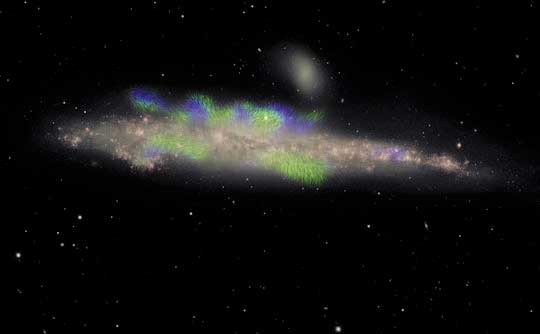| Nov 26, 2019 |
Giant magnetic ropes in the outskirts of a spiral galaxy
|
|
(Nanowerk News) An international consortium led by scientists from the MPIfR in Bonn investigated polarized radio emission from the galaxy NGC 4631 at the VLA radio telescope. They detected for the first time a regular magnetic field over scales of several thousands of light years in the halo of NGC 4631. Moreover, they discovered reversals in the large-scale magnetic field, which they call giant magnetic ropes. T
|
|
his discovery will strengthen the impact of large-scale dynamo theories for spiral galaxies. Further, the regular halo fields may be regarded as a link to intergalactic magnetic fields and will help to understand their origin which is a mystery so far.
|
|
The results are reported in the current issue of the journal Astronomy & Astrophysics ("CHANG-ES XV. Large-scale magnetic field reversals in the radio halo of NGC 4631").
|
|
NGC 4631, the “Whale Galaxy”, located 25 million light-years from Earth in the constellation Canes Venatici, is about 80 thousand light-years across, slightly smaller than our own Milky Way. It was discovered by the famous German-born British astronomer Sir William Herschel in 1787. This galaxy has a companion, NGC 4627, a small elliptical galaxy.
|
|
Observations of the polarized radio emission of NGC 4631, performed with the Karl G. Jansky Very Large Array (VLA), reveal regular magnetic fields protruding above and below the galaxy's disk (see Fig. 1).
|
 |
| The spiral galaxy NGC 4631 is seen edge-on, with its disk of stars shown in pink. The observed magnetic field pattern is displayed by the hair-like structure in green and blue. It extends beyond the disk into the galaxy's extended halo. Green indicates magnetic fields pointing roughly toward us and blue fields pointing away from us. This phenomenon, with the field alternating in direction, has never before been seen in the halo of a galaxy. (Composite image by Jayanne English (Univ. of Manitoba). Radio data: Jansky-VLA (Silvia Carolina Mora-Partiarroyo et al. 2019). Optical data: Mayall 4-meter telescope (Maria Patterson and Rene Walterbos, New Mexico State Univ.). Software code for tracing the magnetic field lines: Arpad Miskolczi (Ruhr-Univ. Bochum)).
|
|
“This is the first time that we have clearly detected what astronomers call large-scale, coherent, magnetic fields far in the halo of a spiral galaxy, with the field lines aligned in the same direction over distances of a thousand light-years. We even see a regular pattern of this organized field changing direction,” said Marita Krause, scientist at the Max Planck Institute for Radioastronomy (MPIfR) in Bonn, Germany, and corresponding author of the publication.
|
|
The strength of 4 microGauss for the regular magnetic field is surprisingly high for a halo, comparable with the regular magnetic field strength in the disks of spiral galaxies.
|
|
An international team of astronomers who are part of a project called the Continuum HAlos in Nearby Galaxies -- an EVLA Survey (CHANG-ES), said the image indicates a large-scale, coherent magnetic field that is generated by dynamo action within the galaxy and spirals far outward in the form of giant magnetic ropes perpendicular to the disk. The CHANG-ES project is led by Judith Irwin of Queen's University in Ontario, Canada, a co-author of the paper.
|
|
“At the moment, I'm afraid that we are a little bit like the blind men and the elephant, since each time we sample the magnetic field in a different way we reach a different conclusion about its nature! However, our models suggest this field includes smaller, twisting cones emanating from the spiral arms,” said Richard Henriksen, also of Queen's University.
|
|
The results were achieved by combining data from multiple observations with the VLA's giant dish antennas arranged in different configurations to show both large structures and finer details within NGC 4631. The naturally-emitted radio waves from that galaxy were analyzed to reveal the magnetic fields, including their directions.
|
|
The scientists said the techniques used to determine the direction of the magnetic field lines can now be used on other galaxies to answer important questions about whether coherent magnetic fields are common in galactic halos and what their shapes are.
|
|
The regular halo fields may also be regarded as a link to intergalactic magnetic fields and will help to understand their origin which is a mystery up to now.
|

